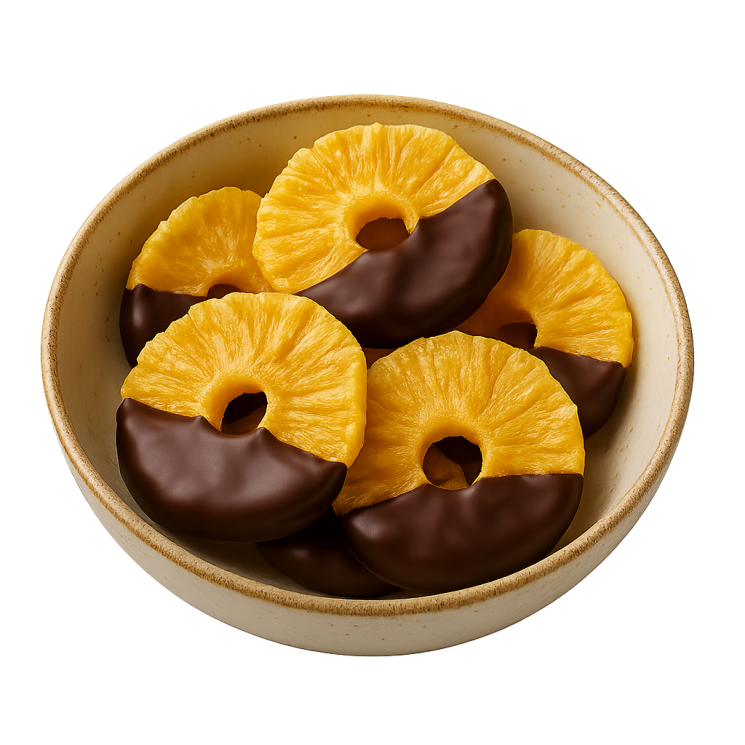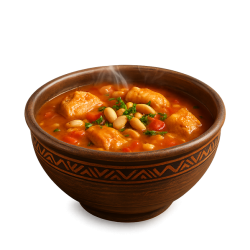Dehydrated Pineapple (Thongsiriporn)
CONSULTATION WITH A SPECIALIST
It is not blocked for now — DOWNLOAD IMO
Place an order via messengers:
Dehydrated Pineapple
Name: Dehydrated Pineapple, Ananas comosus, Getrocknete Ananas, Ananas déshydraté, Piña deshidratada, สับปะรดอบแห้ง
Synonyms: dried pineapple, pineapple rings, fruit snack.
Parts used: fruit flesh (main part — pulp), core, fibrous parts.
Nutritional value: water, dietary fiber, sugars, vitamin C, B-group vitamins, potassium, magnesium, manganese, iron, bromelain.
Main health benefits: antioxidant effect, improved digestion, anti-inflammatory action, immunomodulatory effect, cardiovascular support, strengthening of bone tissue.
Beneficial for conditions: K52 chronic non-infectious enterocolitis, I10 hypertension, I20 ischemic heart disease, E11 type 2 diabetes mellitus (in limited amounts), E66 obesity (within diet), J00–J06 acute upper respiratory tract infections (as a vitamin C source).
Contraindicated for conditions: T78.1 food allergy to pineapple, K29 chronic gastritis with high acidity, K21 gastroesophageal reflux disease, N18 chronic kidney failure, M10 gout, E10 type 1 diabetes mellitus (in large quantities).
Culinary uses: consumed as a snack, added to porridge and muesli, dessert decoration, used in baking, preparation of fruit salads, sauces, compotes, and beverages.
Forms and processed products: dried fruit, candied pineapple, powder, syrup, concentrate, fermented products
Geography and food traditions: Pineapple is a traditional fruit of tropical regions, especially Southeast Asia, Latin America, and Africa. In Thailand, Vietnam, and the Philippines, dehydrated pineapple is popular as a street snack and export product. In Europe and Russia, it is used in confectionery, muesli, and baked goods. In France and Spain, it is added to desserts, while in Germany it is used in Christmas pastries and stollen. In Latin America, dried pineapple is found in sweets and beverages; in traditional Mexican cuisine, it is added to fruit mixes such as “ponche navideño.” Ethnographically, dried pineapple symbolizes solar energy and health; in some regions, it is considered a festive fruit that brings good luck.
Toxicity and food safety: generally safe, but may cause allergic reactions in sensitive individuals. High fructose and organic acid content limit consumption in gastritis and diabetes. Pineapple contains bromelain, which may enhance the effect of anticoagulants.
Product composition: 100% dehydrated pineapple.
Culinary recipes with the product "Dehydrated Pineapple"
Recipe 1: Chicken Salad with Dried Pineapple
Ingredients: 200 g chicken fillet, 50 g dried pineapple, 30 g mayonnaise, 20 g sour cream, 2 g salt, 1 g ground black pepper.
Cooking technology: Boil the chicken fillet for 20 minutes at 100°C (212°F). Let it cool and cut into cubes. Chop the dried pineapple rings into small pieces. In a bowl, combine the chicken and pineapple. Add the mayonnaise, sour cream, salt, and pepper. Mix everything until well combined. Serve chilled.
Nutritional value of the dish: 240 kcal (18g protein, 10g fat, 20g carbohydrates).
Culinary features: This is a popular dish in Russian and Eastern European cuisine, often served on holiday tables and for festive occasions.
Recipe 2. Dessert "Pineapple in chocolate"
Ingredients: 80 g dried pineapple, 100 g dark chocolate, 10 g butter.
Cooking technology: Melt the dark chocolate in a double boiler at 60°C (140°F). Add butter and stir until smooth. Dip dried pineapple pieces into the chocolate mixture. Place them on parchment paper. Refrigerate for 30 minutes until the chocolate hardens.
Nutritional value of the dish: 310 kcal (4g protein, 14g fat, 42g carbohydrates).
Culinary features: This dessert is popular in European and American cuisines and is often served as a sweet snack at celebrations.
| Weight, gross | 220 g |
| Weight | 200 g |
| Made by | Asiabiopharm Co Ltd |
| Country of origin | Thailand |


.png)



0 reviews for Dehydrated Pineapple (Thongsiriporn)